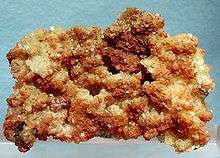Hopeite
| Hopeite | |
|---|---|
|
Hopeite Belgium - Type locality | |
| General | |
| Category | Phosphate minerals |
| Formula (repeating unit) | Zn3(PO4)2·4H2O |
| Strunz classification | 8.CA.30 |
| Crystal system | Orthorhombic |
| Crystal class |
Dipyramidal (mmm) H-M symbol: (2/m 2/m 2/m) |
| Space group | Pnma |
| Identification | |
| Formula mass | 458.17 g/mol |
| Color | Colorless, Gray white, Yellow, White, Light yellow |
| Crystal habit | Encrustations - Forms crust-like aggregates on matrix. Prismatic - Crystals Shaped like Slender Prisms (e.g. tourmaline). Reniform - "Kidney like" in shape (e.g.. hematite). |
| Cleavage | [100] Perfect, [010] Good, [001] Poor |
| Fracture | Uneven - Flat surfaces (not cleavage) fractured in an uneven pattern. |
| Mohs scale hardness | 3-3.5 |
| Luster | Vitreous (Glassy) |
| Streak | white |
| Specific gravity | 3 |
| Optical properties | Biaxial (-), a=1.572-1.574, b=1.582-1.591, g=1.59-1.592 |
| Other characteristics | non-radioactive, non-magnetic |
Hopeite is a hydrated zinc phosphate with formula: Zn3(PO4)2·4H2O. It is a rare mineral used mainly as a collectors specimen.
Hopeite crystallizes in the orthorhombic system with prismatic, vitreous white to yellow crystals. It also forms druzy encrustations and reniform (kidney-shaped) masses. The related mineral parahopeite, which has the same composition but different crystal structure, is triclinic. The minerals are formed through oxidation of sphalerite by the presence of phosphate-rich solutions
It was first described in 1822 from Moresnet, Liège Province, Belgium and is named after Scottish chemist, Thomas Charles Hope (1766–1844) of Edinburgh University.
It has been found in Zambia associated with lazulite.
References

Orange-brown hopeite prisms to 3 mm on a nearly solid matrix of glassy, pastel yellow-green parahopeite crystals. Locality: Kabwe Mine (Broken Hill Mine), Kabwe, Central Province, Zambia. Broken Hill is the type locality for parahopeite.
| Wikimedia Commons has media related to Hopeite. |
This article is issued from Wikipedia - version of the 11/19/2016. The text is available under the Creative Commons Attribution/Share Alike but additional terms may apply for the media files.
